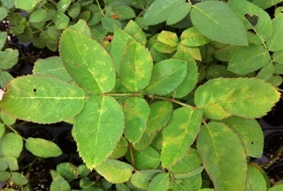Downy Mildew (Peronospera sparsa)


Symptons
Leaves affected by the disease turn yellow in parches or segments with often some redish-purple colours at the periphery, parts of the leaf stay initially green. The affected leaves drop easily from the plant at the slightest touch.
Conditions
Development of Downy Mildew occurs under conditions of low temperatures (< 16° C) and high humidity (> 85%). The development of the disease is negatively affected by a temperature above 28° C for 8 hours or more.
Control and Measures
These conditions indicate that the disease is controllable by climate management. Often the lower temperatures cannot be changed under conditions of semi-open green houses, but humidity can be reduced. Ventilation is foremost important to reduce accumulation of high humidity. This can be done by forced air circulation through horizontal fans above the crop, creating air circulation in the green house or natural ventilation by opening the side vents. Air-circulation is most important at sunrise when humidity is highest. An open crop in the period of risk of Downy Mildew is helpful. Remove bent stems gradually before the period of Downy Mildew conditions. Care has to be taken that the green house topsoil in pathways and of bed shoulders is dry at sunset. This helps to avoid a build up of humidity during the night. During the day, the temperature in the green house is increased by closing somewhat the side vents well before the sun sets to catch some warmth for the night. In the morning once the temperature gets around 30° C, vents can be opened somewhat because ventilation is important to decrease humidity.
Plant Protection
Plants can be protected with several chemical products. There are products which are used preventively, some are sprayed over the plants, others are given to the soil to be absorbed by the plants. There are also products which attack the disease and are used for curative action. Products have to be interchanged according to code of action according to Fungicide Resistance Action Committee (FRAC) to avoid resistance to the chemical. Do not spray early morning, but wait till the green house warms up. Make sure the plants dry up quickly and are surely dry at the end of the day.
Weather Condition
Since the development of the disease takes place under special climatic conditions, possible infection can be predicted or expected. Under the favourable circumstances preventive products can be applied and the curative products can be used if any infection is suspected, the earlier the better.
Under all circumstances have a good look on the development of the disease. It starts at certain places, never the whole green house at the time, but development can be very fast, less than 24 hours. Although intensive spraying may be necessary at short period of time, spray as less as possible. Dare to relax the spraying, while watching the crop. Last but not least, have chemicals in stock, especially at the time downy can be expected.
Chemicals
FRAC M3` (many products) 1.5 – 2.0 gr/ltr
FRAC 4
Metalaxil + mancozeb (Ridomil and others) 1.5 gr / ltr (systemic)
mancozeb together with metalaxil has a synergetic effect. To be applied before infection (preventive), against sporulation.
FRAC 27
cymoxanil (Curzate) 1.5 gr / ltr (curative)
cymoxanil is systemic and curative. Has a negative effect on plants in stress. Not compatible in alkaline conditions.
FRAC 11
Cymoxanil + famoxadon (Equation Pro) 1.0 ml/ltr
famoxadon (oxazolidinedion). Strong antifungal to be applied preventive. Interchange to avoid resistance. Mitochondrial inhibitor.
FRAC M5
clorothalonil (Kavach) 1.5 / ltr Notes:
Non systemic, preventive. May produce phototoxicity.
FRAC 40
dimethamorph (Acrobat) 1.2 / ltr
Systemic, curative, breaks down cell membrane of fungus.
FRAC 33
phosathyl-aluminium (Aliette)
Drenching through drip line @ 2 gr / ltr. Curative. Not on young plants.
FRAC 3
propiconazole (triazole group) (Dhan, Indofil)
Works similar to dimethamorph, stress reduction.
FRAC 11
Pyraclostrobin + metiram (Cabrio Top) Also as soil application.
Azoxystrobin (strobilurin) (Amistar) 1 ml / ltr
Kresoxim methyl (Ergon) 1.0 ml/ltrspraying or drenching through drip line 1 ml / ltr
Notes: All products are based on strobilurin, as natural extraction or synthesized product. Strong effect against sporulation, hence best applied before infection. Has a good after-effect during inoculation. Systemic and growth stimulating. Quick resistance development.


